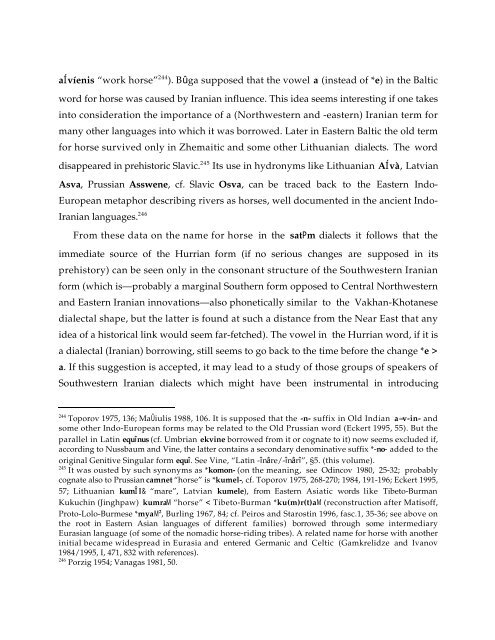Comparative Notes on Hurro-Urartian, Northern Caucasian
Comparative Notes on Hurro-Urartian, Northern Caucasian
Comparative Notes on Hurro-Urartian, Northern Caucasian
Create successful ePaper yourself
Turn your PDF publications into a flip-book with our unique Google optimized e-Paper software.
aÍvíenis “work horse” 244 ). Bûga supposed that the vowel a (instead of *e) in the Baltic<br />
word for horse was caused by Iranian influence. This idea seems interesting if <strong>on</strong>e takes<br />
into c<strong>on</strong>siderati<strong>on</strong> the importance of a (Northwestern and -eastern) Iranian term for<br />
many other languages into which it was borrowed. Later in Eastern Baltic the old term<br />
for horse survived <strong>on</strong>ly in Zhemaitic and some other Lithuanian dialects. The word<br />
disappeared in prehistoric Slavic. 245 Its use in hydr<strong>on</strong>yms like Lithuanian AÍvà, Latvian<br />
Asva, Prussian Asswene, cf. Slavic Osva, can be traced back to the Eastern Indo-<br />
European metaphor describing rivers as horses, well documented in the ancient Indo-<br />
Iranian languages. 246<br />
From these data <strong>on</strong> the name for horse in the satPm dialects it follows that the<br />
immediate source of the Hurrian form (if no serious changes are supposed in its<br />
prehistory) can be seen <strong>on</strong>ly in the c<strong>on</strong>s<strong>on</strong>ant structure of the Southwestern Iranian<br />
form (which is—probably a marginal Southern form opposed to Central Northwestern<br />
and Eastern Iranian innovati<strong>on</strong>s—also ph<strong>on</strong>etically similar to the Vakhan-Khotanese<br />
dialectal shape, but the latter is found at such a distance from the Near East that any<br />
idea of a historical link would seem far-fetched). The vowel in the Hurrian word, if it is<br />
a dialectal (Iranian) borrowing, still seems to go back to the time before the change *e ><br />
a. If this suggesti<strong>on</strong> is accepted, it may lead to a study of those groups of speakers of<br />
Southwestern Iranian dialects which might have been instrumental in introducing<br />
244 Toporov 1975, 136; MaÛiulis 1988, 106. It is supposed that the -n- suffix in Old Indian a≈v-in- and<br />
some other Indo-European forms may be related to the Old Prussian word (Eckert 1995, 55). But the<br />
parallel in Latin equînus (cf. Umbrian ekvine borrowed from it or cognate to it) now seems excluded if,<br />
according to Nussbaum and Vine, the latter c<strong>on</strong>tains a sec<strong>on</strong>dary denominative suffix *-no- added to the<br />
original Genitive Singular form equî. See Vine, “Latin -înâre/-înârî”, §5. (this volume).<br />
245 It was ousted by such syn<strong>on</strong>yms as *kom<strong>on</strong>- (<strong>on</strong> the meaning, see Odincov 1980, 25-32; probably<br />
cognate also to Prussian camnet “horse” is *kumel-, cf. Toporov 1975, 268-270; 1984, 191-196; Eckert 1995,<br />
57; Lithuanian kumÎl& “mare”, Latvian kumele), from Eastern Asiatic words like Tibeto-Burman<br />
Kukuchin (Jinghpaw) kumraM “horse” < Tibeto-Burman *ku(m)r(t)aM (rec<strong>on</strong>structi<strong>on</strong> after Matisoff,<br />
Proto-Lolo-Burmese *myaM 2 , Burling 1967, 84; cf. Peiros and Starostin 1996, fasc.1, 35-36; see above <strong>on</strong><br />
the root in Eastern Asian languages of different families) borrowed through some intermediary<br />
Eurasian language (of some of the nomadic horse-riding tribes). A related name for horse with another<br />
initial became widespread in Eurasia and entered Germanic and Celtic (Gamkrelidze and Ivanov<br />
1984/1995, I, 471, 832 with references).<br />
246 Porzig 1954; Vanagas 1981, 50.





